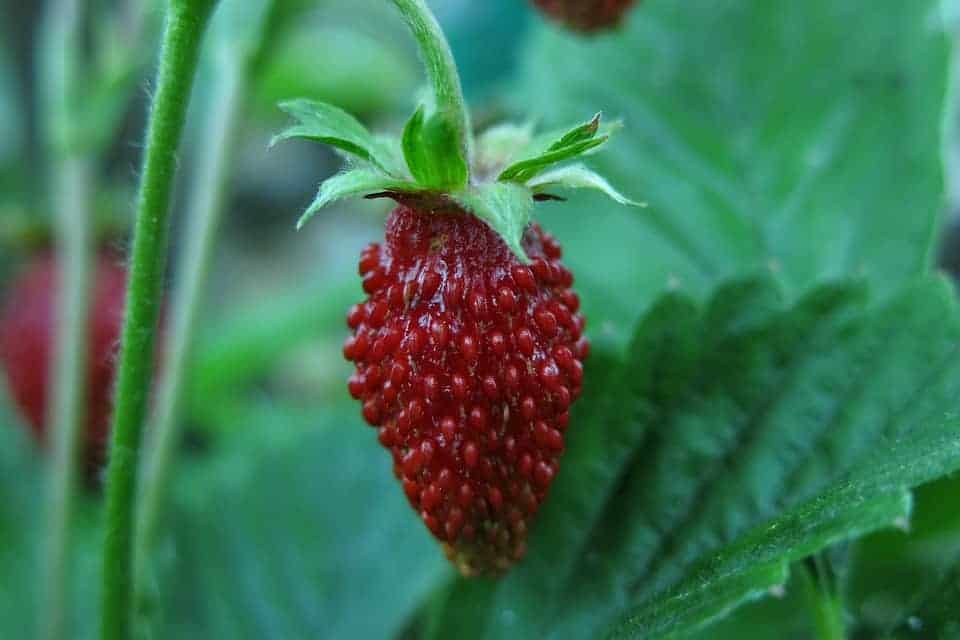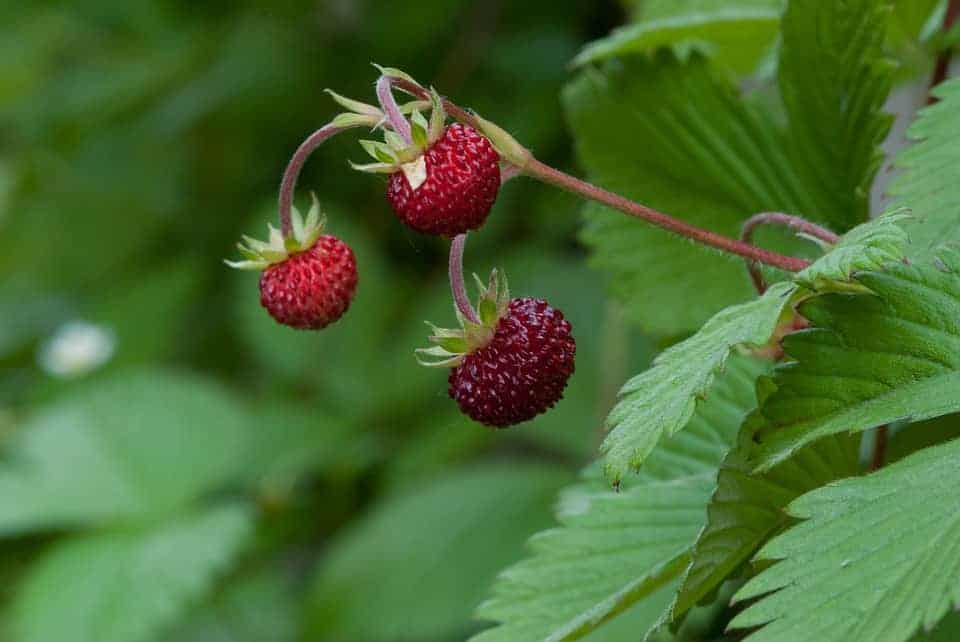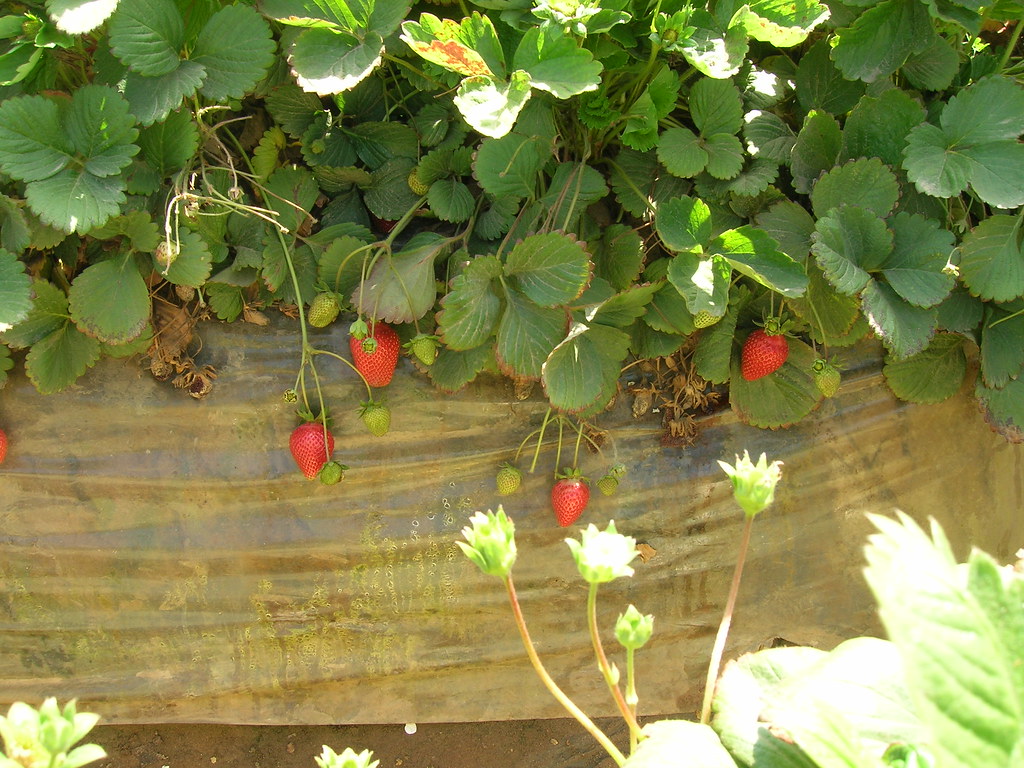Strawberries are probably one of the easiest fruits to grow in containers because of their compact growth habit and relatively quick maturity. Most strawberries will thrive in containers, but some varieties are better suited for container gardening.
One thing you will notice is that most of the strawberries on this list are wild strawberries (also called alpine or woodland strawberries). That’s because wild strawberries naturally grow as a mound or small bush, and produce few to no runners, which is perfect for containers. However, mature plants can also be divided if you want to propagate them. Another advantage is that they grow readily from seed, making it cheaper to start growing them. All the varieties below are also day-neutral, everbearing varieties, meaning they continually produce flowers and fruit from summer until late fall (often lasting up to the first frost).
| Variety | Type | Propagated via | Fruit Description |
|---|---|---|---|
| Albion | Common Garden Strawberry, Everbearing | Runners | Large, regular fruit |
| Alexandria | Wild Strawberry, Everbearing | Seeds, dividing plants | Small, elongated fruit |
| Mignonette | Wild Strawberry, Everbearing | Seeds, dividing plants | Small, round fruit |
| Yellow Wonder | Wild Strawberry, Everbearing | Seeds, dividing plants | Small, pale yellow, elongated fruit |
| Fresca | Common Garden Strawberry, Everbearing | Seeds, runners, dividing plants | Medium-sized regular fruit |
On this page:
5 Best Strawberry Varieties for Containers
Albion
Prolific, large-fruited strawberry with delectably sweet fruits and dependable yields
Fruiting time: Mid Summer to First Frost
Type: Common Garden Strawberry (Day-Neutral/Everbearing)
Hardiness Zone: 4 to 8
Propagates via: Runners
Get plants: Johnny’s Selected Seeds (US), Burpee (US), Nourse Farms (US), Hand Picked Nursery (US), Veseys (Canada), Linden Lane Farms (Canada)
A tried-and-true variety, Albion produces large, uniform strawberries that are very sweet and has a reputation for having high-yielding plants. Albion berries are also more firm than other sugary varieties like Seascape strawberries. This variety is a day-neutral, everbearing plant which will bloom and fruit all the way up to the first frost.
Since Albion produces runners like most strawberry varieties, they should not share a container with other vegetables or fruits, since they will naturally sprawl out and fill out (and actually overflow) even a large raised bed. In addition, because of this, you will need to clear out overcrowded strawberry plants every few years, but extra plants and runners can simply be transplanted into new containers. But for some, this is another reason to grow Albion, since a few plants can multiply into dozens after a few years.
Albion plants are very hardy down to Zone 8, and has good disease resistance, especially against verticillium wilt and multiple crown rots. Highly recommended for all gardeners, whether growing in containers, baskets, garden beds, or hydroponic systems.
Alexandria
Aromatic, productive, hardy little wild strawberry, perfect for both small and large containers
Fruiting time: Mid Summer to First Frost
Type: Alpine/Wild/Woodland Strawberry (Everbearing)
Hardiness Zone: 6 to 8
Propagates via: Seeds or dividing mature plants
Get seeds: MIGardener (US), Baker Creek (US), Johnny’s Selected Seeds (US), Incredible Seeds (Canada), Chiltern Seeds (UK)
Get plants: Burpee (US)

Alpine or wild strawberries are hardy with very sweet fruits, and Alexandria is no exception. Wild strawberries are smaller than regular strawberries, but make up for their size in sweetness and aroma. Alexandria strawberries are deep red and packed with flavor. They are also everbearing, meaning they will produce flowers and fruits continuously from summer up to the first frost.
Alexandria is noted for its extreme hardiness, with some gardeners having plants survive down to frigid -40°F (-40°C) temperatures, however they are normally rated for Hardiness Zones 6 to 8 (down to -10°F/-23°C).
Another benefit of alpine strawberries is that they do not grow via runners. Instead, the plants just grow into a larger clump and propagate via seeds. You can also divide mature plants to propagate them vegetatively. This makes Alexandria strawberries ideal for small containers or if you want strawberries that are not too invasive in a large container or garden bed.
Overall, Alexandria is one of most recommended alpine/wild varieties to grow, especially in containers and hanging baskets.
Mignonette
Prolific, bushy French heirloom with cute, uniquely-flavored berries that is adapted to a variety of climates
Fruiting time: Mid Summer to First Frost
Type: Alpine/Wild/Woodland Strawberry (Everbearing)
Hardiness Zone: 4 to 9
Propagates via: Seeds or dividing mature plants
Get seeds: Burpee (US), Renee’s Garden Seeds (US), West Coast Seeds (Canada), William Dam Seeds (Canada), Thompson & Morgan (UK), Chiltern Seeds (UK)

One of the most popular alpine strawberry varieties, Mignonette is prized for its productive yields and delicious, uniquely-flavored red berries. The flavor is described as being fruity with slightly nutty notes. Mignonette tends to grow larger berries than other alpine/wild varieties (around 3/4-inch berries), but they’re still not as large as regular strawberries.
Mignonette also forms a bushier growth habit than Alexandria, forming a bushy mound with a 12-inch spread, making one plant per hanging basket or container ideal. Container size should also ideally be at least 10 inches in diameter and a minimum of 6-8 inches deep to allow enough space for growth. However, you can plant multiple Mignonette strawberry plants in a larger container since they do not form runners.
Yellow Wonder
Sweet, pale yellow gourmet strawberries that are less prone to bird damage
Fruiting time: Mid Summer to First Frost
Type: Alpine/Wild/Woodland Strawberry (Everbearing)
Hardiness Zone: 6 to 8
Propagates via: Seeds or dividing mature plants
Get seeds: Baker Creek (US), Select Seeds (US), West Coast Seeds (Canada), Premier Seeds Direct (UK)
Get plants: Burpee (US)
Strawberries don’t only come in red, with white, yellow, and sometimes even purple varieties. Yellow Wonder is an alpine/wild strawberry that ripens to a pale yellow color when ripe.
People grow Yellow Wonder for its unique color but the yellow fruit are actually less likely to be eaten by birds than red strawberries [1][2][3]. So if you hate birds eating your strawberries, try growing yellow varieties. (No guarantees that squirrels won’t touch them, though!)
In terms of growth habit, Yellow Wonder is like other alpine strawberries in that it grows as a small runnerless bush, at least 12 inches in diameter.
Fresca
Possibly the only regular garden strawberry that can be grown from seed, with plump, firm fruit
Fruiting time: Mid Summer to First Frost
Type: Common Garden Strawberry (Day-Neutral/Everbearing)
Hardiness Zone: 4 to 8
Propagates via: Seeds, runners, or dividing mature plants
Get seeds: Urban Farmer Seeds (US), Kitchen Garden Seeds (US), Swallowtail Garden Seeds (US), West Coast Seeds (Canada), Early’s (Canada), Moles Seeds (UK)
As far as we know, Fresca is the only variety of common garden strawberry (not wild/alpine/woodland type) that you can successfully grow from seed. These are medium-sized strawberries, about 1 inch with wide shoulders and a tapered end, and fairly firm just like those at the grocery store.
This is a day-neutral, everbearing variety, so you can expect flowers and fruit from summer until your first frost. However, if starting from seed, start indoors early, in January or February, to get fruit in your first year.
Fresca also has the benefit of having a compact, bushy growth habit similar to wild strawberries, but also produce runners (although less than other varieties like Albion), making it easier for you to propagate mature plants and expand your strawberry garden. This also makes Fresca ideal for both containers and raised beds.
Why Wild Strawberries Are Better for Containers
There are a few reasons why wild strawberries are better for containers. First, wild strawberries tend to grow as a mound or bush instead of a sprawling plant with runners. Second, wild strawberries put out few to no runners compared to common garden strawberries. That means it will take longer for wild strawberry plants to crowd each other out in a container.
But what makes them great for containers is also a possible disadvantage in raised beds. Regular strawberries put out lots of runners, and can quickly fill out an entire raised bed on their own. You will need to grow and plant out many more wild strawberries to fill the same raised bed. However, because wild strawberries spread out more slowly, that could be an advantage if you want to plant them along the edge of a bed or plant wild strawberries among other perennials.
Related Questions About Wild Strawberries
Why Are Wild Strawberries Always Small?
Wild strawberries are small because they have not been bred to have large fruit like common garden strawberries.
In nature, there’s no need for a wild strawberry to use the extra energy to grow large fruit since a small fruit is just large enough to attract birds to eat it and disperse the seeds in their droppings. This is also the same reason why wild chili peppers are often small and berry-like. Common garden strawberries are hybrids which are bred for larger fruit.
Do Wild Strawberries Grow in Shade?
While wild strawberries can survive in partial shade, all strawberries, wild and common, grow best and produce more blooms and fruit in full sun (at least 6 hours of direct sun per day).
Can You Grow Wild Strawberries Indoors?
Wild strawberries can be easily grown indoors, but will require additional lighting. Most $50-100 LED grow lights are often more than enough to support the growth of wild strawberries (Mars Hydro and SANSI are two well-known brands of affordable, consumer-grade LED grow lights). Note that wild strawberries are all everbearing, so you don’t need to worry about constantly changing the lighting schedule to induce flowering. A photoperiod (light cycle) of 12 to 14 hours per day is sufficient to grow strawberries.



